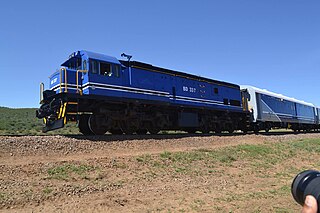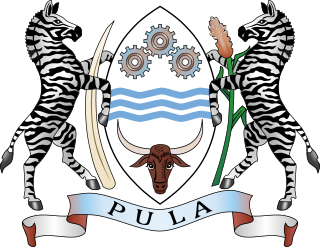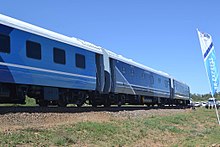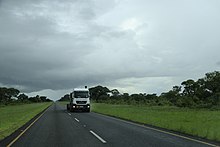Different methods of transportation in South Africa include roads, railways, airports, water, and pipelines for petroleum oil. The majority of people in South Africa use informal minibus taxis as their main mode of transport. BRT has been implemented in some South African cities in an attempt to provide more formalised and safer public transport services. These systems have been widely criticised due to their large capital and operating costs. A "freeway" is different from most countries as certain things are forbidden which include certain motorcycles, no hand signals, and motor tricycles. South Africa has many major ports including Cape Town, Durban, and Port Elizabeth that allow ships and other boats to pass through, some carrying passengers and some carrying petroleum tankers.

Gaborone is the capital and largest city of Botswana with a population of 246,325 based on the 2022 census, about 10% of the total population of Botswana. Its agglomeration is home to 421,907 inhabitants at the 2011 census.

Palapye is a growing town in Botswana, situated about halfway between Francistown and Gaborone. Over the years its position has made it a convenient stopover on one of Southern Africa's principal north–south rail and road routes.
Air Botswana Corporation is Botswana's state-owned national flag carrier, with its headquarters located in Gaborone. It operates scheduled domestic and regional flights from its main base at Sir Seretse Khama International Airport. Air Botswana has been loss-making for several years, and there have been various attempts to privatise the company, and frequent changes to the corporation's management and board, so far without reducing the losses.
The government of Zimbabwe is the main provider of air, rail and road services; historically, there has been little participation of private investors in transport infrastructure.

Francistown is the second-largest city in Botswana, with a population of about 103,417 and 147,122 inhabitants for its agglomeration at the 2022 census. It is located in eastern Botswana, about 400 kilometres (250 mi) north-northeast from the capital, Gaborone. Francistown is located at the confluence of the Tati and Ntshe rivers, and near the Shashe River and 90 kilometres (56 mi) from the international border with Zimbabwe.

Kasane is a town in Botswana, close to Africa's 'Four Corners', where four countries almost meet: Botswana, Namibia, Zambia and Zimbabwe. It is at the far north-eastern corner of Botswana where it serves as the administrative center of the Chobe District. The population of Kasane was 9,244 in 2011 census.

Botswana Railways (BR) is the national railway of Botswana.
Ramokgwebana is a village in the North-East District of Botswana, close to the eastern border, which is defined by the Ramokgwebana River. Plumtree, Zimbabwe is on the other side of the border crossing.

Rail services in Botswana are provided by Botswana Railways in Botswana. Most routes in the country radiate from Gaborone. The railway network consists of 888 km, its gauge is 1,067 mm cape gauge.

The Kazungula Ferry was a pontoon ferry across the 400-metre-wide (1,300 ft) Zambezi River between Botswana and Zambia. It was one of the largest ferries in south-central Africa, having a capacity of 70 tonnes. The service was provided by two motorised pontoons and operated between border posts at Kazungula, Zambia and Kazungula, Botswana.

The Shashe River is a major left-bank tributary of the Limpopo River in Zimbabwe. It rises northwest of Francistown, Botswana and flows into the Limpopo River where Botswana, Zimbabwe and South Africa meet. The confluence is at the site of the Greater Mapungubwe Transfrontier Conservation Area.
List of Railway stations in Botswana include:

The A1 highway in Botswana is a road that runs from the Zimbabwean border near Ramokgwebana through Francistown, Mahalapye, Palapye, Gaborone and Lobatse, to Ramatlabama at the border with South Africa. Crossing the Ramokgwebana River into Zimbabwe, it continues as the A7 to Bulawayo. On the South African end it continues as the N18 to Mahikeng.
The A2 highway is a road in Botswana running from the Namibian border at Buitepos through Jwaneng, Kanye and Lobatse to the South African border at Pioneer Gate.

Bechuanaland National Airways was the national airline of the Bechuanaland Protectorate and was based in Francistown.

First Capital Bank Botswana Limited, formerly known as Capital Bank, is a commercial bank in Botswana, licensed by the Bank of Botswana, the central bank and national banking regulator. It is a subsidiary of FMBCapital Holdings Plc, a Mauritius-based financial services conglomerate, whose shares of stock are listed on the Malawi Stock Exchange and has subsidiaries in Botswana, Malawi, Mozambique, Zambia and Zimbabwe.
Prostitution in Botswana is not illegal, but laws such as public disorder, vagrancy, loitering and state recognised religious provisions are used to prosecute prostitutes. Related activities such as soliciting and brothel keeping are illegal. Botswana has made proposals to make prostitution legal to prevent the spread of AIDS. However, there has been mass opposition to it by the Catholic Church. Prostitution is widespread and takes place on the street, bars, hotels, brothels and the cabs of long-distance trucks.

The High Court of Botswana is the highest court of Botswana. It is based in Gaborone with branches in Lobatse, Francistown, and Maun. It operates above the Magistrates' Courts of Botswana, but below the Appeal Court. The High Court is headed by the Chief Justice of Botswana.
The Mosetse–Kazungula–Livingstone Railway is a prospected 430 kilometres (270 mi) cape gauge international railway connecting the Botswana railway network at Mosetse, Botswana with the Zambian railway network at Livingstone, Zambia over the new Kazungula Bridge on the Zambezi River.

































